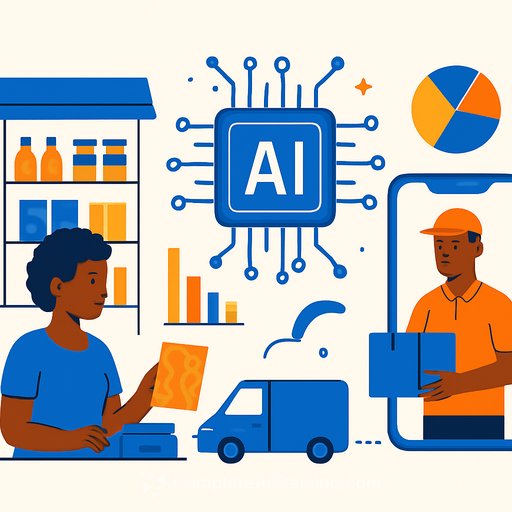Data and AI set to transform Africa's FMCG market
November 7, 2025
The FMCG sector is entering a new phase of scale and speed. Valued at USD 12.93 trillion in 2024 and projected to reach USD 21.9 trillion by 2034 (CAGR 5.40%), demand is being pulled by urbanisation, changing habits, e-commerce, and smarter decisioning. Generative AI spend is set to rise from USD 7.9 billion in 2023 to USD 57.7 billion by 2033, unlocking faster product development, better trend sensing, and sharper consumer engagement.
For product development teams, the signal is clear: AI and data are no longer optional. They decide who wins.
Global FMCG: what's moving the market
- Personalised demand creation: AI-driven recommendations, dynamic pricing, and CRM-triggered offers tied to real behaviour.
- Health-first product pipelines: Growth concentrates in "better-for-you" food and beverages, functional formats, and clean labels. Build variants that hit price points without losing quality.
- Faster product loops: Use generative AI to scan reviews, social, and sales data to draft concepts, claims, pack copy, and A/B test creatives in hours, not weeks.
- Assortment and pack architecture: Price elasticity and store clusters guide where to launch value packs, refills, or premium lines.
South Africa: complexity meets innovation
Retail sales reached R1.4 trillion in 2023, with FMCG at R845.6 billion. Modern trade contributed R452 billion; informal trade added R184 billion through spaza shops, hawkers, and independent convenience. A further R209 billion came from pharmacies, health & beauty, liquor, wholesale/cash & carry, and direct selling.
Discounters (Boxer, Usave, SaveMor) grew 13.9% year-on-year. E-commerce rose by 40%+, led by Checkers Sixty60, PnP asap!, SPAR2U, and Woolies Dash. Online spend grew 23% year-to-date (Aug 2025) with share rising from 7% (2022) to 11%, and food's share increasing from 19.8% to 22.5%. Supermarkets still dominate, premium formats outperform value chains, and informal retail expanded by 5.2% due to convenience.
Households remain under pressure. Food inflation eased to 4.5% in 2024 from 10.8% in 2023, yet the basic basket is 26% higher than in 2021. Average transaction value stayed negative from H1 2022 to H1 2025 (from -5% to -3%), while transaction volumes outpaced value-clear evidence of smaller, more frequent baskets.
What to build next in this environment:
- Price-point engineering: Expand micro and mid-size packs to hit key cash denominations. Design refill and bundle mechanics for value without eroding margin.
- AI-first forecasting: Use predictive models at SKU x store level to plan shelf-ready packs, reduce waste, and improve service levels.
- Digital last mile: Plan products for quick-commerce (pack durability, leak-proofing, heat sensitivity) and township delivery constraints.
- Health and wellness adjacencies: Pharmacies and wellness chains carry margin; build SKUs and claims that fit their missions and space constraints.
Rest of Africa: youth, urbanisation, and mobile-first retail
The broader African FMCG market is estimated at roughly USD 346 billion today and is projected to approach USD 568 billion in the coming years. With 60% of the population under 25, demand is shifting toward packaged foods, personal care, and convenient formats.
Mobile money (e.g., M-Pesa) reduces friction where infrastructure is weak, and informal retail can account for up to 80% of sales in some markets. Digital platforms enable direct-to-consumer and better links into kiosks and mom-and-pop stores. Companies are already using AI for product recommendations, inventory control, and retailer loyalty-practical tools that move volume.
Product development focus areas:
- Sachet and starter sizes: Fit daily cash flow and small-basket realities while preserving brand equity.
- Heat, shelf-life, and transport tolerance: Engineer for long distances and non-refrigerated storage.
- WhatsApp/USSD-friendly journeys: Ensure offers, referrals, and reorders work on low-data channels.
- Retailer-first programs: AI-powered replenishment suggestions and simple loyalty mechanics to lock in repeat orders.
Build the intelligent product org
"AI and data are no longer optional; they decide who wins in global, African, and South African FMCG." That statement matches what the numbers show-and it's executable right now.
Practical data stack (start small, connect fast):
- Data to capture: Sell-in/out by SKU, store and channel attributes, promo calendars, price ladders, returns, stock-outs, NPS/reviews, delivery SLAs.
- Models to run: Demand forecasting, promo lift, price elasticity, assortment and route-to-market optimisation, replenishment triggers, next-best-offer.
- Ops wiring: Push recommendations into merch plans, trade promotions, e-commerce PDPs, and field sales tools. Audit decisions weekly.
- Guardrails: Privacy-by-design, consent and opt-out flows, POPIA compliance, bias checks on pricing and offers.
90-day plan for product leaders
- Days 0-30: Pick two SKUs and two channels (e.g., discounter + quick-commerce). Define success metrics: forecast accuracy, on-shelf availability, conversion, repeat.
- Days 31-60: Clean the data, train baseline models, and run a pack-size and price test across 20-50 stores plus one e-commerce route. Instrument analytics end to end.
- Days 61-90: Roll out winning variants to the next 5x stores, wire replenishment alerts to field teams, publish a one-page playbook for scaling.
KPIs that matter
- Forecast accuracy uplift at SKU x store
- On-shelf availability and wasted stock
- Contribution margin by pack size
- Promo ROI and price elasticity by cluster
- Time-to-concept and time-to-shelf
- Repeat purchase and cohort retention
Where to go from here
E-commerce, discounters, and informal retail will keep pulling the market in different directions. The teams that win will ship SKUs that fit each channel and make faster calls using live data.
If you're upskilling your team on practical AI for product work, explore curated programs by role: AI courses by job.
Sources: expertmarketresearch.com for global FMCG estimates; Market.us on Generative AI growth; verifiedmarketresearch.com for Africa FMCG projections.
Your membership also unlocks:






